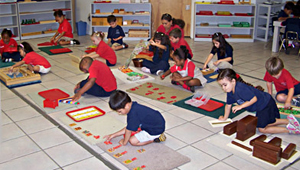The Montessori Method Encourage Natural Learning
Mr. Samir Al Baghdadi
A Focus on Children
Driving through neighborhoods in most larger American cities, you will find the usual shopping centers, public schools, and homes. You will also often come across an innocuous sign in front of a converted residence or small building. The simple sign will state Montessori or Montessori School. This will indicate the presence of a small private school that uses teaching concepts for preschoolers based on what is called the Montessori Method.
Maria Montessori opened the first of what would eventually become thousands of Montessori classrooms in 1907 in a poor section of Rome. She called her small school the Casa del Bambini, or the Children’s House. Her success and innovative methods caught on quickly with educators around the globe, and over the next decades schools could be found in cities worldwide from Europe to South America, eventually including every continent except Antarctica.
The movement has been widely studied and evaluated, resulting in a large body of literature discussing the Montessori Method and approach. The first of these came from Dr. Montessori herself, when she set forth principles and concepts of child-centered education in her first book, published in 1909.
The Basics of the Concept
Montessori’s focus on the child’s natural approach to learning lies at the heart of its methodology. It starts with a belief in every child’s inherent thirst for learning and knowledge. The concept presumes this attitude and provides a supportive and environment carefully planned to encourage that learning process. It also seeks to incorporate a holistic approach to a child’s development in all areas, including physical, social, cognitive, and emotional dimensions.
While over time variants of the method have developed and are offered to parents, a true Montessori Method learning environment will offer:
- Groupings of children in multiage clusters to encourage peer learning experiences
- Blocks of uninterrupted work time
- Guidance of the child in selecting work projects and activities
- Availability of the proprietary Montessori learning materials
- A soothing and pleasing environment that is conducive to learning without stress
The overall approach envisions a triangle composed of the teacher, the child, and the environment in which instruction takes place. A major innovative component introduced by Dr. Montessori is offering the children a sense of independence and freedom (within limits) in the classroom while maintaining an order to the process. In this framework of gentle control and guidance, a child is allowed to choose his or her own areas of learning, turning to the teacher for additional guidance or support when they feel the need for it.
An additional cornerstone of the concept is the use of multiage groups. This further facilitates the natural process of younger children learning from older ones in a flowing, interactive process. This not only teaches the younger child, it allows the older to reinforce the concepts and insights over which they have gained mastery. Dr. Montessori felt this element also reflects the environment in which children will live and grow, learning in the real world from people of all ages.
Why Montessori?
More than a century of actual application of the initial concepts of Montessori has taken place since the first introduction via the Casa dei Bambini. This time has allowed a thorough testing and proving of a number of the benefits that are derived from the approach. Supporters and advocates of the method point to such things as:
- Development of the individual. As there are multiple learning styles, the method accommodates individual ways of learning and allows children to move at their own pace
- An appreciation for community. The multiage groups and special learning environment provide children with an early appreciation for order, community and independence with limits.
- Cultivation of a lifelong pursuit of learning. Learning is positioned as a source of joy and further independence, not a boring chore.
- Self-correction. Children learn that errors are a natural part of learning and are encouraged to assess and correct themselves.
From a solid foundation, it appears that the Montessori Method will continue to flourish as a valued form of instruction for children as it enters its second century of application.
Search
News

رئيس جامعة الناصر الاستاذ الدكتور عبدالله حسين طاهش يقوم بزيارة تفقدية للجان والقاعات الامتحانية الخاصة بكلية الهندسة وعلوم الحاسوب الاثنين 24 فبراير 2025
قام رئيس الجامعة الاستاذ الدكتور عبدالله حسين ط...
جامعة الناصر تنظم ورشة حول التهيئة الرمضانية لمنتسبيها
نظمت جامعة الناصر صباح اليوم الأثنين 25 شعبان 1...
اختتام المؤتمر العلمي الأول للجامعات اليمنية في صنعاء
اختتم اليوم في العاصمة صنعاء، أعمال المؤتمر الع...
لليوم الثاني على التوالي، استمرار أعمال ونقاشات المؤتمر العلمي الأول للجامعات اليمنية.
تستمر في العاصمة صنعاء لليوم الثاني على التوالي...
بمشاركة جامعة الناصر وبحضور رسمي رفيع انطلاق المؤتمر العلمي الأول في صنعاء
صنعاء 20 شعبان 1446 هجرية الموافق 18 فبراير 202...

